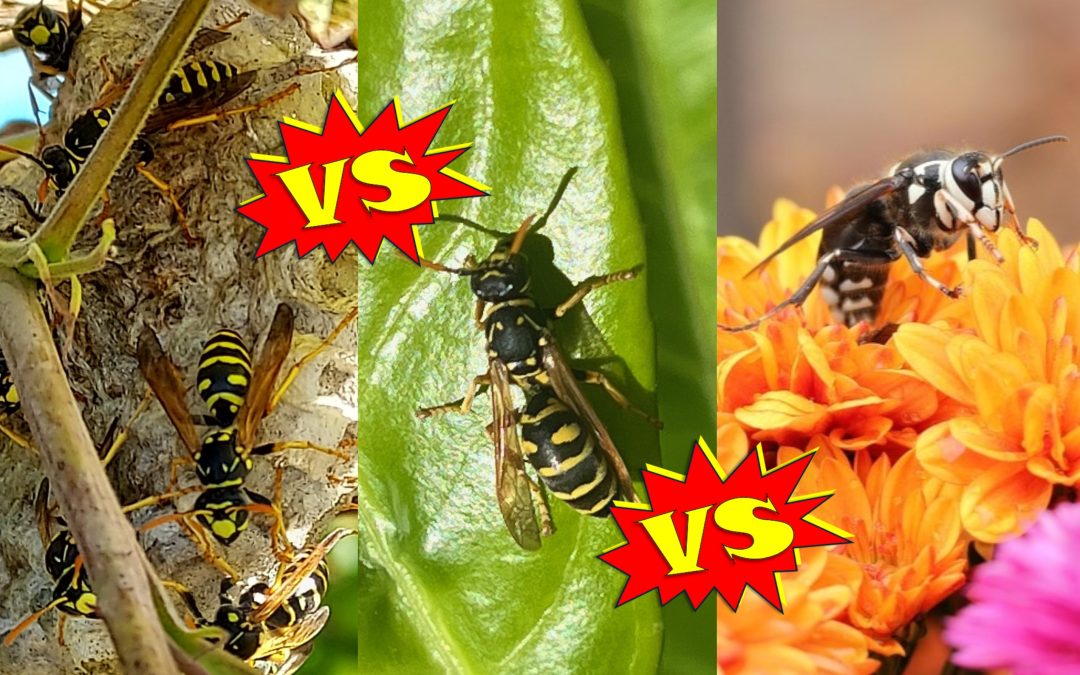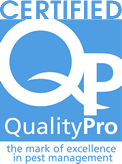Here in Oregon, we often encounter Paper Wasps, Yellow Jackets, and Bald-Faced Hornets buzzing around, especially as summer rolls in. While they may seem similar at first glance, these insects have distinct characteristics and behaviors that set them apart. Understanding these differences is key to identifying them correctly and knowing how to handle potential encounters.
Key Takeaways
- It can be difficult to distinguish Yellow Jackets from Paper Wasps from honey bees.
- Bald Faced Hornets are easier to identify given their striking black and white coloring.
- Bald Faced Hornets are not pleasant.
- Paper wasps are more docile and easier to control.
- Allergic reactions to stings can be dangerous or possibly life-threatening. Seek emergency help immediately when needed.
- Traps placed early in the spring can help reduce the number of Yellow Jackets you see later in the summer.
What are Yellow Jackets?
Yellow Jackets are a type of wasp that is often mistaken for bees due to their coloration and similar size. Scientifically known as Vespula spp. or Dolichovespula spp., are aggressive wasps known for their bright yellow and black markings. They are social insects that live in colonies led by a queen, with worker yellow jackets defending the nest vigorously. These wasps are scavengers, feeding on sugary substances like fruit and nectar, as well as proteins such as insects and meats.
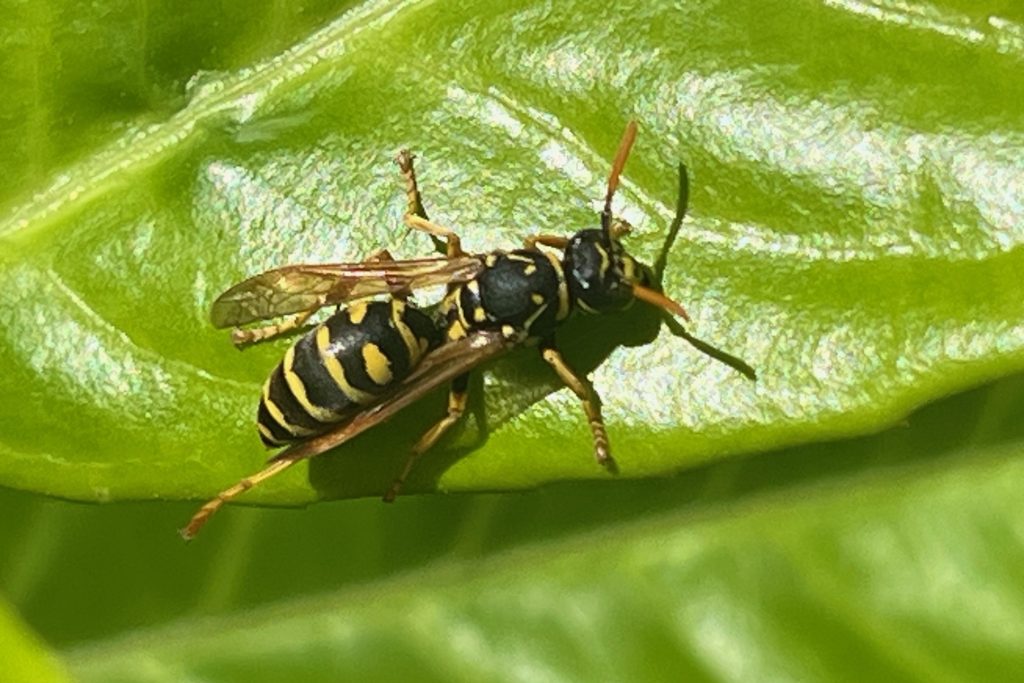
A yellow jacket queen perched on a leaf, showcasing her distinctive markings.
What are Paper Wasps?
Paper Wasps, scientifically known as Polistes spp., are a common type of wasp found throughout Oregon and many other parts of North America. They are named for the paper-like material they use to construct their nests, which is created by chewing wood fibers mixed with their saliva. They typically have more slender bodies with long legs, of which the rear ones tend to hang down during flight. Paper wasps have a distinctive long, thin waist that clearly separates their thorax from their abdomen.
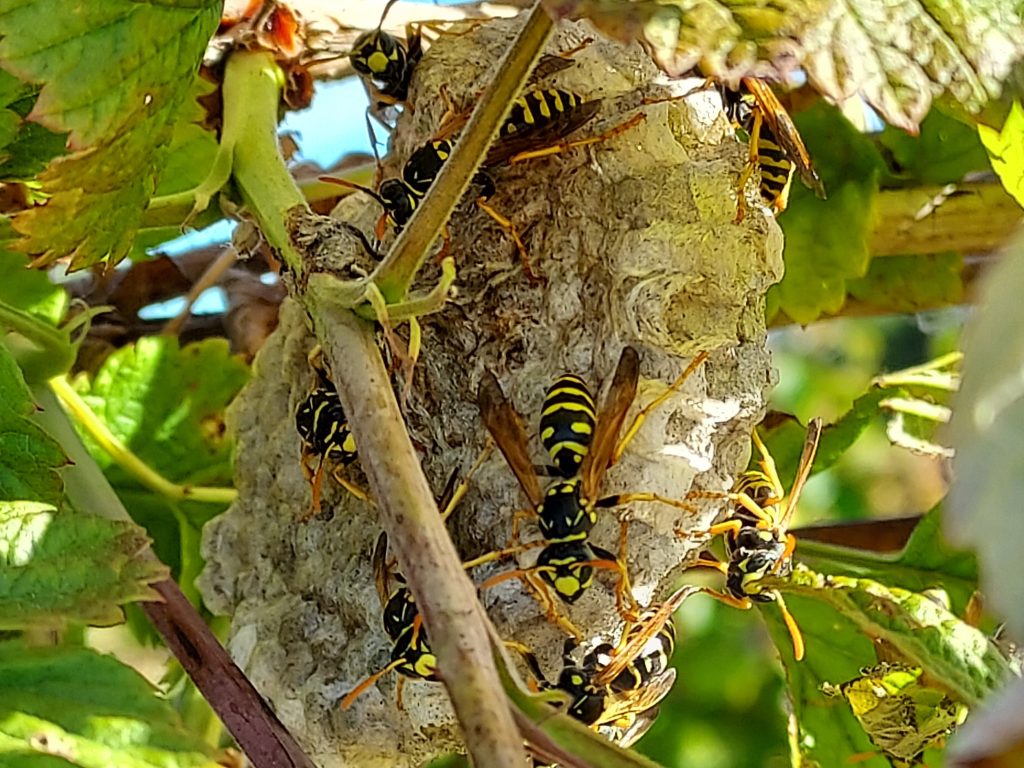
A paper wasp nest with several wasps visible, nestled in the branches of a bush.
What are Bald Faced Hornets?
Here’s a fun one: Bald-Faced Hornets aren’t true hornets; they’re actually a type of wasp, despite their name. They’re distinguished by their striking coloration, mostly black with a white or “bald-faced” head. If you dare to get closer, you might also notice white stripes on their bodies. These insects are social, forming colonies led by a queen, and they are known for their aggressive defense of their nests. Bald-faced hornets build large paper-like nests, often high in trees or shrubs, which can become a concern for homeowners due to their size and defensive nature.
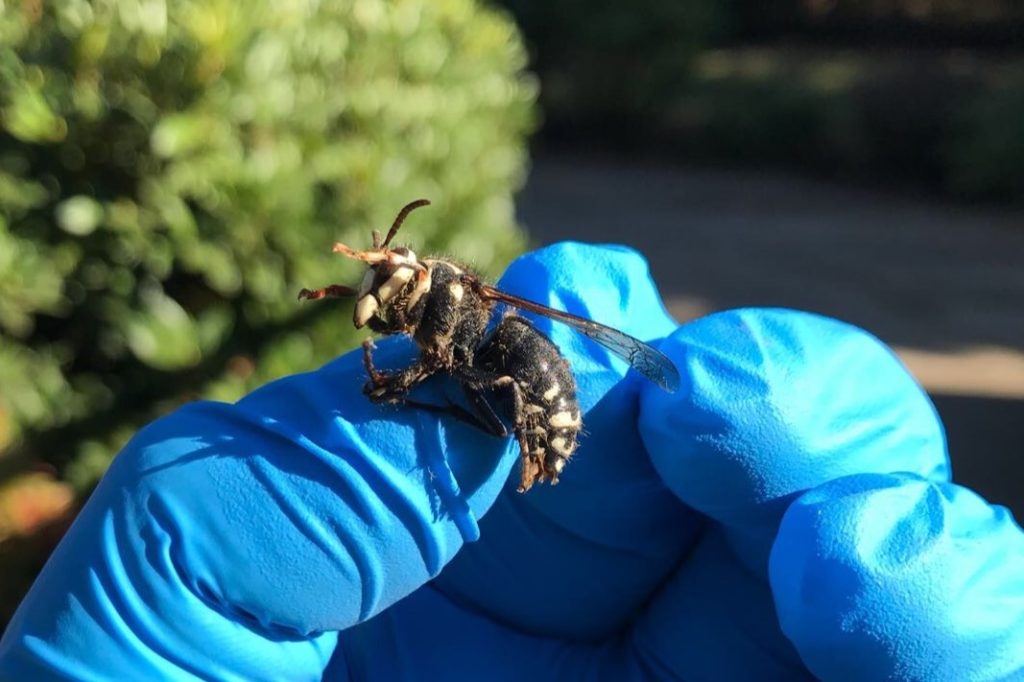
A technician holds a dead bald-faced hornet, showcasing the insect’s distinctive black and white coloration.
For more info on wasps of all types, click HERE to read our wasps breakdown article.
Nesting Habits
Paper Wasps:
Paper Wasps are known for their umbrella-shaped nests, which they construct by chewing wood fibers into a paper-like substance. These nests are often found hanging from eaves, porch ceilings, or under decks. Paper Wasps are generally less aggressive unless provoked, and their nests typically contain fewer individuals compared to other wasp species.
Yellow Jackets:
We have multiple species of Yellow Jackets here in Oregon. Some are ground nesters and also build nests in voids such as wall cavities, attics, and sometimes underground. Their nests are made of paper-like material but are enclosed with a distinctive entrance hole. Yellow Jacket colonies can grow quite large, with hundreds to thousands of workers, particularly as summer progresses. They are aggressive defenders of their nests and can sting repeatedly if threatened.
Some species of Yellow Jackets will build ariel nests much like hornets do. This can make identification difficult and might be best left to the professionals.
Bald-Faced Hornets:
Bald-Faced Hornets construct large, football-shaped nests made from chewed wood fibers mixed with their saliva. These nests are usually attached to trees, shrubs, or structures like houses. Bald-Faced Hornets are known for their aggressive defense of their nests and can deliver painful stings. Their colonies can reach significant sizes, with hundreds of workers.
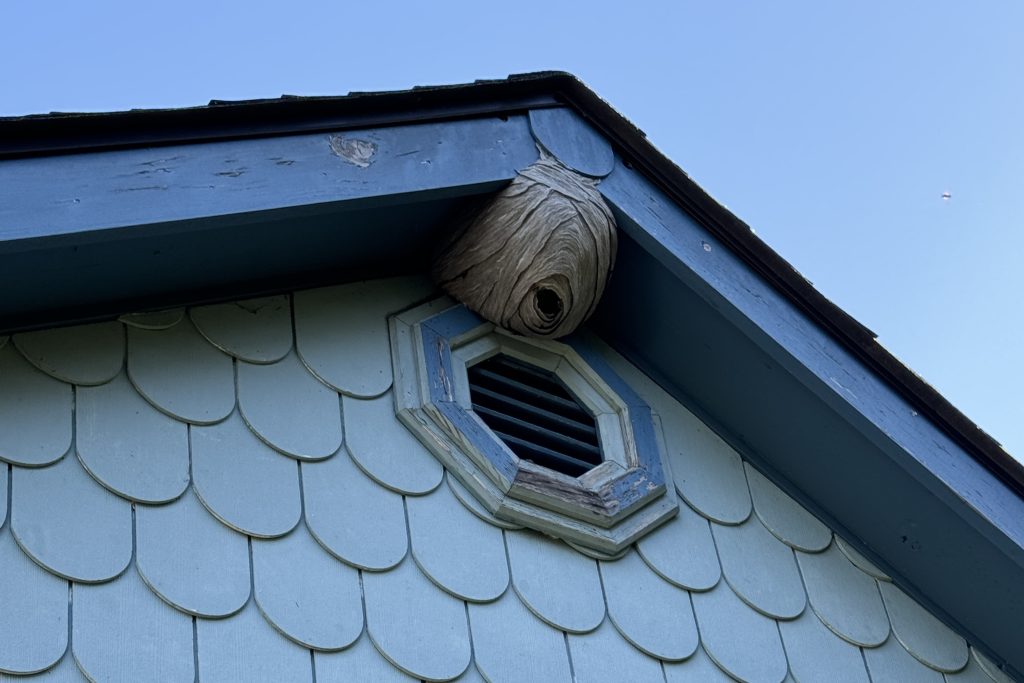
A yellow jacket nest built in the eave of a home in Eugene, Oregon, highlighting the importance of regular inspections and preventive measures.
Behavioral Differences
Paper Wasps:
Paper Wasps are generally less aggressive compared to Yellow Jackets and Bald-Faced Hornets. They are known to be beneficial pollinators and can help control pest insect populations in gardens.
Yellow Jackets:
Yellow Jackets are aggressive defenders of their nests and can sting multiple times. They are scavengers and are often attracted to sugary foods and drinks, which can lead to encounters with humans during outdoor activities.
Bald-Faced Hornets:
Bald-Faced Hornets are highly territorial and will aggressively defend their nests if they feel threatened. They have a reputation for delivering painful stings and should be approached with caution.
Hazards and Risks
When dealing with Paper Wasps, Yellow Jackets, and Bald-Faced Hornets, understanding the hazards they pose is crucial for ensuring safety. These insects can be particularly dangerous, especially for those who are allergic to their stings. Here’s what you need to know about the risks and safety precautions:
Pain and Swelling: Stings from these insects are painful and can cause significant swelling and redness around the sting site. The severity can vary depending on the individual and the number of stings received.
Allergic Reactions: For individuals with allergies to insect venom, stings can trigger severe reactions, including anaphylaxis. Symptoms may include difficulty breathing, swelling of the face and throat, rapid heartbeat, and dizziness. Immediate medical attention is necessary if an allergic reaction occurs.
Multiple Stings: Unlike bees, which can only sting once, wasps, Yellow Jackets, and Bald-Faced Hornets can sting multiple times. This increases the risk of more severe reactions and complications, particularly if a nest is disturbed, leading to numerous stings.
Infection Risk: Scratching or improper care of sting sites can lead to secondary infections. It’s important to clean and monitor sting sites for signs of infection, such as increased redness, warmth, or spreading pain.
If you start to show signs of an allergic reaction after being stung by a wasp, Yellow Jacket, or Bald-Faced Hornet, it’s crucial to act quickly. Common signs of an allergic reaction include difficulty breathing, swelling of the face or throat, hives, dizziness, and a rapid or weak pulse. If you or someone around you experiences these symptoms, call 911 or your local emergency number immediately. Anaphylaxis, a severe allergic reaction, can progress rapidly and is life-threatening without prompt medical intervention.
After receiving emergency treatment, follow up with a healthcare professional to discuss prevention strategies and possibly obtaining an epinephrine auto-injector for future incidents.
For less severe reactions, antihistamines can help reduce itching, swelling, and hives. However, always consult a healthcare provider for guidance tailored to your specific situation. Remember, prompt action and medical attention are key to effectively managing allergic reactions and ensuring safety.
Prevention Tips
For Paper Wasps, Yellow Jackets, and Bald-Faced Hornets:
- Avoid disturbing nests: If you spot a nest, keep a safe distance and avoid any actions that might disturb the insects. Disturbed nests can lead to aggressive swarming and multiple stings.
- Regular Inspections: Periodically inspect your property for nests, especially in early summer when colonies are establishing themselves.
- Put out traps: Placing pheromone traps early in the year (April – May) can help reduce the number of stinging wasps greatly. For more information, click HERE to read our article on traps.
- Seal Entry Points: Seal cracks and crevices around windows, doors, and utility penetrations to prevent these insects from entering your home.
- Keep Food Covered: During outdoor activities, keep food and drinks covered to avoid attracting Yellow Jackets, especially.
- Trim Vegetation: Trim shrubs and trees near your home to reduce potential nesting sites for Bald-Faced Hornets and Paper Wasps.
- Professional Inspection: Consider a professional pest inspection, especially if you suspect a nest but are unsure of its location or how to safely handle it.
When to Call a Professional
When it comes to these stinging insects, you might not be thrilled to get up close and personal. Sometimes, it is best to get a professional involved rather than doing it yourself. If You Have:
Multiple Nests: If you notice multiple nests on your property, especially if they belong to aggressive species like Yellow Jackets or Bald-Faced Hornets.
Large Nests: Large nests can pose significant risks, especially near high-traffic areas or if someone in your household is allergic to stings.
Tricky Nest Location: Some nests will be located in hard to reach areas, such as in walls, close to entryways, or in a bush or shrub.
Uncertain Identification: If you are unsure about the type of nest or the species of wasp or hornet present, it’s safer to call a professional who can safely handle and remove the nest.
By understanding the nesting habits, behaviors, and identifying features of Paper Wasps, Yellow Jackets, and Bald-Faced Hornets, you can better protect yourself and your home from these stinging insects. Remember, prevention and early identification are key to managing potential infestations safely and effectively.
Stay informed, stay safe, and stay pest free!

